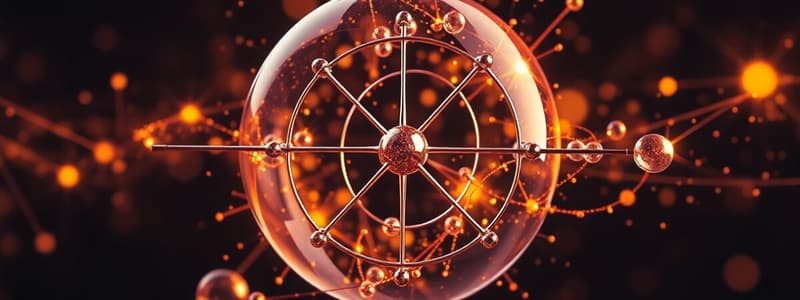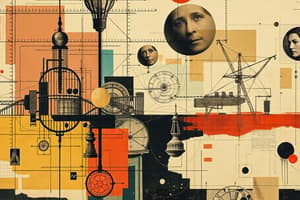Podcast
Questions and Answers
What does Faraday's law describe?
What does Faraday's law describe?
- The generation of energy through friction.
- The induction of voltage due to a changing magnetic field. (correct)
- The effect of a current on a magnetic field.
- The relationship between temperature and energy transfer.
Which phenomenon occurs when light is entirely reflected at the boundary between two media?
Which phenomenon occurs when light is entirely reflected at the boundary between two media?
- Diffraction
- Refraction
- Reflection
- Total Internal Reflection (correct)
What does quantum mechanics primarily describe?
What does quantum mechanics primarily describe?
- The concepts of gravity and motion in everyday life.
- The curvature of spacetime due to mass.
- Energy levels and light behavior at large scales.
- The behavior of matter and energy at atomic and subatomic levels. (correct)
Which concept explains the bending of light as it passes from one medium to another?
Which concept explains the bending of light as it passes from one medium to another?
What is a significant application of general relativity?
What is a significant application of general relativity?
What does Newton's first law of motion state?
What does Newton's first law of motion state?
How is acceleration defined in classical mechanics?
How is acceleration defined in classical mechanics?
What does the second law of thermodynamics state?
What does the second law of thermodynamics state?
Which statement best describes Coulomb's law?
Which statement best describes Coulomb's law?
What does the first law of thermodynamics imply about energy?
What does the first law of thermodynamics imply about energy?
Flashcards
Classical Mechanics
Classical Mechanics
The study of motion of macroscopic objects based on Newton's laws.
Newton's First Law
Newton's First Law
An object at rest stays at rest and an object in motion stays in motion with the same speed and in the same direction unless acted upon by an unbalanced force.
Newton's Second Law
Newton's Second Law
The acceleration of an object is directly proportional to the net force acting on it and inversely proportional to its mass.
Newton's Third Law
Newton's Third Law
Signup and view all the flashcards
Thermodynamics
Thermodynamics
Signup and view all the flashcards
Temperature
Temperature
Signup and view all the flashcards
Heat
Heat
Signup and view all the flashcards
Internal Energy
Internal Energy
Signup and view all the flashcards
First Law of Thermodynamics
First Law of Thermodynamics
Signup and view all the flashcards
Electromagnetism
Electromagnetism
Signup and view all the flashcards
Electric Charge
Electric Charge
Signup and view all the flashcards
Coulomb's Law
Coulomb's Law
Signup and view all the flashcards
Ampere's Law
Ampere's Law
Signup and view all the flashcards
Faraday's Law
Faraday's Law
Signup and view all the flashcards
Reflection (Optics)
Reflection (Optics)
Signup and view all the flashcards
Refraction (Optics)
Refraction (Optics)
Signup and view all the flashcards
Diffraction (Optics)
Diffraction (Optics)
Signup and view all the flashcards
Interference (Optics)
Interference (Optics)
Signup and view all the flashcards
Total Internal Reflection
Total Internal Reflection
Signup and view all the flashcards
Quantum Mechanics
Quantum Mechanics
Signup and view all the flashcards
Special Relativity
Special Relativity
Signup and view all the flashcards
General Relativity
General Relativity
Signup and view all the flashcards
Study Notes
Classical Mechanics
- Classical mechanics describes the motion of macroscopic objects, such as planets, cars, and balls.
- It's based on Newton's laws of motion.
- Key concepts include:
- Force: A push or pull that can change an object's motion.
- Mass: A measure of an object's inertia (resistance to acceleration).
- Acceleration: The rate of change of an object's velocity.
- Newton's first law: An object at rest stays at rest and an object in motion stays in motion with the same speed and in the same direction unless acted upon by an unbalanced force.
- Newton's second law: The acceleration of an object is directly proportional to the net force acting on it and inversely proportional to its mass. (F=ma)
- Newton's third law: For every action, there is an equal and opposite reaction.
- Applications: Calculating trajectories, predicting motion, and analyzing forces in various physical systems.
Thermodynamics
- Thermodynamics studies the relationships between heat, work, and energy.
- Key concepts include:
- Temperature: A measure of the average kinetic energy of the particles in a substance.
- Heat: Energy transferred between objects due to a temperature difference.
- Work: Energy transferred to or from an object by a force acting through a distance.
- Internal energy: The total energy of the particles within a system.
- Zeroth law: If two systems are each in thermal equilibrium with a third, then they are in thermal equilibrium with each other.
- First law: Energy can be transferred and transformed, but it cannot be created or destroyed. (ΔU=Q-W)
- Second law: The total entropy of an isolated system can never decrease over time.
- Third law: The entropy of a perfect crystal at absolute zero temperature is zero.
- Applications: Designing engines, understanding phase transitions, and analyzing heat transfer in various systems.
Electromagnetism
- Electromagnetism describes the interactions between electric charges and magnetic fields.
- Key concepts include:
- Electric charge: A fundamental property of matter that causes electric forces.
- Electric field: A region of space where an electric charge experiences a force.
- Magnetic field: A region of space where a moving electric charge or a magnetic dipole experiences a force.
- Coulomb's law: The force between two point charges is directly proportional to the product of their charges and inversely proportional to the square of the distance between them.
- Ampere's law: The magnetic field around a current-carrying wire is proportional to the current.
- Faraday's law: A changing magnetic field induces an electromotive force (voltage) in a conductor.
- Applications: Generating electricity, designing motors, and understanding electromagnetic waves.
Optics
- Optics studies the behavior of light.
- Key concepts include:
- Reflection: The bouncing of light off a surface.
- Refraction: The bending of light as it passes from one medium to another.
- Diffraction: The spreading of light as it passes through an opening or around an obstacle.
- Interference: The combination of two or more light waves to produce a resultant wave.
- Total Internal Reflection: The phenomenon where light is completely reflected at the boundary between two media when it travels from a denser to a rarer medium at an angle greater than the critical angle.
- Applications: Designing telescopes, microscopes, and lenses. Understanding phenomena like rainbows and mirages.
Modern Physics
- Modern physics encompasses principles and theories developed in the 20th century, like quantum mechanics and relativity.
- Key concepts include:
- Quantum mechanics: Describes the behavior of matter and energy at the atomic and subatomic level. Quantum mechanics introduces concepts such as quantized energy levels and wave-particle duality.
- Special relativity: Describes space and time as a unified four-dimensional entity and the relationship between space and time, depending on the observer's relative speed.
- General relativity: Describes gravity as a curvature of spacetime caused by mass and energy.
- Applications: Developing technologies like lasers, nuclear energy, and understanding the behavior of elementary particles.
Studying That Suits You
Use AI to generate personalized quizzes and flashcards to suit your learning preferences.




